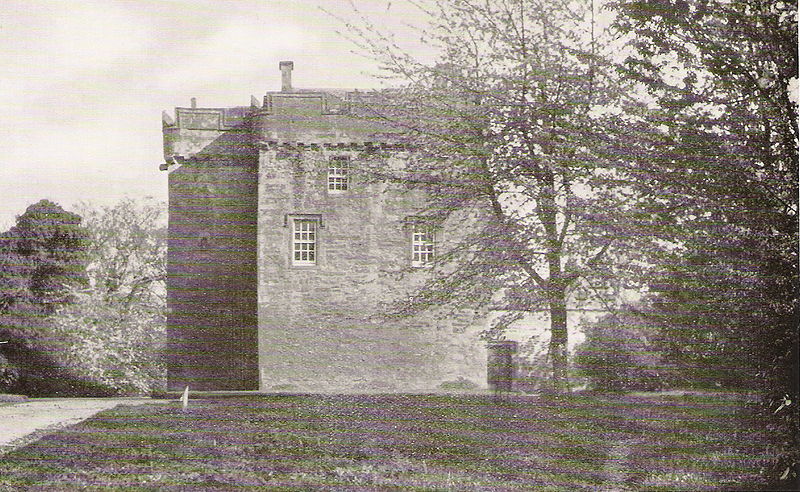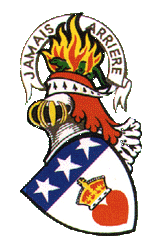 Whittingehame
is a parish with a small village in East Lothian, Scotland, about halfway
between Haddington and Dunbar, and near East Linton. The area is on the
slopes of the Lammermuir Hills. Whittingehame Tower dates from the 15th
century and remains a residence. Whittingehame
is a parish with a small village in East Lothian, Scotland, about halfway
between Haddington and Dunbar, and near East Linton. The area is on the
slopes of the Lammermuir Hills. Whittingehame Tower dates from the 15th
century and remains a residence.
The barony was anciently the
possession of the Dunbar Earls of March family, and Chalmers' Caledonia
records that they held their baronial court there. In 1372 George de Dunbar,
10th Earl of March, gave in marriage with his sister Agnes to James Douglas
of Dalkeith, the manor of Whittingehame, with the patronage of the Chapel.
The Douglases remained in possession for over 200 years: about 1537
Elizabeth (d. after August 1557), daughter of Sir Robert Lauder of The Bass
(d. 1517/18), married William Douglas of Whittingehame, and in October 1564
Mary, Queen of Scots, confirmed to their son, William Douglas of
Whittinghame (d. 17 December 1595), a Senator of the College of Justice, the
barony of Whittingham, the castle, mills, and the avowson of the Church
there, ratified by parliament on 19 April 1567. This William Douglas had
married in 1566 Elizabeth (d. after 6 August 1608), daughter of Sir Richard
Maitland of Lethington, a Senator of the College of Justice.
It is
said that the plot to murder Mary's husband, Lord Darnley, was discussed at
length at Whittingehame castle in 1566, and in March of that year "William
Douglas of Whittingehame, brother to Master Archibald Douglas parson of
Douglas", is cited as one of those in the conspiracy to murder David Riccio.
On 26 August 1582 William Douglas of Whittingehame is cited as one of the
Ruthven raiders.
On 28 December 1630, Sir Archibald Douglas, 5th of
Whittingehame, son and heir of William and Elizabeth, was a witness to the
baptism of Archibald Sydserf at Whittingehame Church, but by 1640 Sir
Archibald was dead with no issue. Whittingehame passed to his brother Sir
William Douglas of Stoneypath, near Garvald, whose daughter Isobel married,
in 1628, Sir Arthur Douglas of the Kellour family, and their daughter
Elizabeth (1632–1668) married, in 1652, Alexander Seton, 1st Viscount of
Kingston and carried Whittingehame to him (Elizabeth's brother Archibald
having died unmarried). Their youngest daughter Elizabeth, carried
Whittingehame to her husband William Hay of Duns and Drumelzier, Peebleshire,
upon their marriage in 1695. The Hays, as proprietors, were highly esteemed
by their tenants.
In 1817 they sold Whittingehame and
Stoneypath,
near Garvald, to James Balfour (father of the Politician Arthur James
Balfour, Whittingehame, East Lothian, Scotland, 1848 - Woking, Surrey,
1930), second son of John Balfour, 5th of Balbirnie in Fife, who had made a
large fortune in India. James Balfour subsequently enlarged his estate by
buying up a great many adjoining properties. By 1900 there were about 25
farms on the Whittingehame estate. The coal mines on their Fife lands
greatly increased their prosperity throughout the 19th century.
James
Balfour engaged James Dorward, from Haddington, to build a new neo-classical
mansion and offices to designs by Sir Robert Smirke, Whittingehame House,
completed about 1817, with additions and alterations by architect William
Burn ten years later. This became the family home of the Balfours and the
birth-place of the Prime Minister Arthur Balfour[1] and the scientist
Francis Maitland Balfour. Between 1939 and 1941, Whittingehame was converted
into a school for Jewish refugee children coming to Britain through the
Kindertransport. The school, known as the Whittingehame Farm School,
sheltered 160 children between the ages of 7 and 17. This building, a huge
country house and A-listed, still stands, albeit now divided into private
apartments. It is not open to the public. Having passed through various
hands after the Balfours (at one time it was a private school - Holt School,
but it closed and the property lay dormant.) there is still much of interest
to see, including a spectacular ceiling to the dining room.
A
parochial school, of which the laird was patron, was long established at
Whittingehame, and in 1742 Mr James Hogg was appointed schoolmaster there,
transferred from neighbouring Morham.
In 1820 James Balfour rebuilt
the church, supplanting the previous rebuild of 1722, and then established,
in 1840, a new model village to the north-west of the former medieaval
settlement. It consist of a schoolhouse and a string of cottages, all in red
sandstone.
in the early 1950 to 1955 it was a boarding school it was
called Whittingehame house school for boys then a few years later it was
used as a school called Holts Academy, it lasted just a few years, after
that time it was sold off and converted to 3 or 4 apartments, It Was a
beautiful house, school, and setting. Hugh Gray JP
The Ghost of Whittingehame
Whittingehame is associated with a folk legend
of a ghost that belonged to an unbaptised child
who could not enter the afterlife
due to his circumstances.
See also:
|
|


